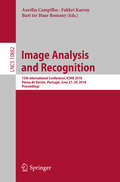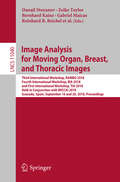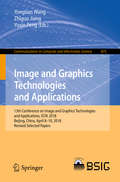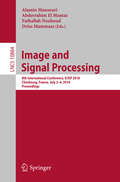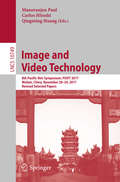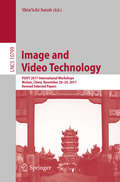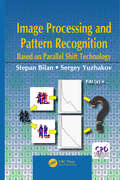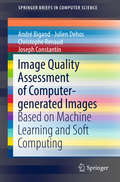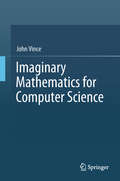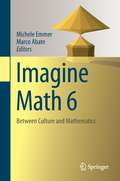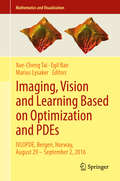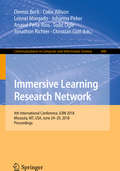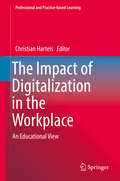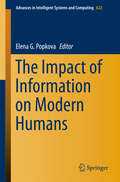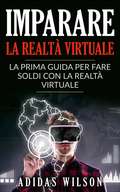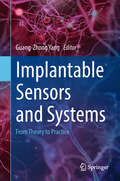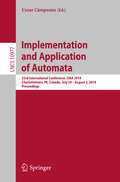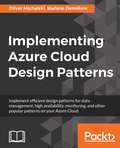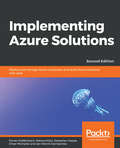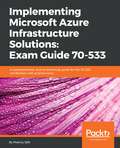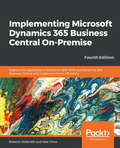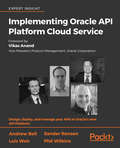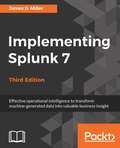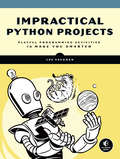- Table View
- List View
Image Analysis and Recognition: 15th International Conference, ICIAR 2018, Póvoa de Varzim, Portugal, June 27–29, 2018, Proceedings (Lecture Notes in Computer Science #10882)
by Aurélio Campilho Fakhri Karray Bart ter Haar RomenyThis book constitutes the thoroughly refereed proceedings of the 15th International Conference on Image Analysis and Recognition, ICIAR 2018, held in Póvoa de Varzim, Portugal, in June 2018.The 91 full papers presented together with 15 short papers were carefully reviewed and selected from 179 submissions. The papers are organized in the following topical sections: Enhancement, Restoration and Reconstruction, Image Segmentation, Detection, Classication and Recognition, Indexing and Retrieval, Computer Vision, Activity Recognition, Traffic and Surveillance, Applications, Biomedical Image Analysis, Diagnosis and Screening of Ophthalmic Diseases, and Challenge on Breast Cancer Histology Images.
Image Analysis for Moving Organ, Breast, and Thoracic Images: Third International Workshop, RAMBO 2018, Fourth International Workshop, BIA 2018, and First International Workshop, TIA 2018, Held in Conjunction with MICCAI 2018, Granada, Spain, September 16 and 20, 2018, Proceedings (Lecture Notes in Computer Science #11040)
by Andrew P. Bradley Jens Petersen Kensaku Mori Gustavo Carneiro Kanwal Bhatia Bernhard Kainz Lena Maier-Hein Tom Vercauteren Danail Stoyanov Zeike Taylor Anne Martel Gabriel Maicas Reinhard R. Beichel Ozan Oktay Jacinto Nascimento Hang Min Matthew S. Brown Colin Jacobs Bianca Lassen-Schmidt Raúl San José Estépar Alexander Schmidt-Richberg Catarina VeigaThis book constitutes the refereed joint proceedings of the Third International Workshop on Reconstruction and Analysis of Moving Body Organs, RAMBO 2018, the Fourth International Workshop on Breast Image Analysis, BIA 2018, and the First International Workshop on Thoracic Image Analysis, TIA 2018, held in conjunction with the 21st International Conference on Medical Imaging and Computer-Assisted Intervention, MICCAI 2018, in Granada, Spain, in September 2018. The 5 full papers (out of 10 submissions) presented at RAMBO, the 9 full papers (out of 18 submissions) presented at BIA, and the 20 full papers (out of 21 submissions) presented at TIA were carefully reviewed and selected. The RAMBO papers cover aspects of medical imaging where motion plays a role in the image formation or analysis. The BIA papers deal with topics such as computer-aided detection and diagnosis of breast cancer, quantitative analysis of breast imaging modalities, and large scale breast image screening and analysis. The TIA papers cover aspects of image analysis research for lung and cardiac diseases including segmentation, registration, quantification, modeling of the image acquisition process, visualization, validation, statistical modeling, biophysical lung modeling (computational anatomy), deep learning and novel applications.
Image and Graphics Technologies and Applications: 13th Conference On Image And Graphics Technologies And Applications, Igta 2018, Beijing, China, April 8-10, 2018, Revised Selected Papers (Communications In Computer And Information Science #875)
by Yongtian Wang Zhiguo Jiang Yuxin PengThis book constitutes the refereed proceedings of the 13th Chinese Conference on Image and Graphics Technologies and Applications, IGTA 2018, held in Beijing, China in April, 2018. The 64 papers presented were carefully reviewed and selected from 138 submissions. They provide a forum for sharing progresses in the areas of image processing technology; image analysis and understanding; computer vision and pattern recognition; big data mining, computer graphics and VR; as well as image technology applications.
Image and Signal Processing: 8th International Conference, ICISP 2018, Cherbourg, France, July 2-4, 2018, Proceedings (Lecture Notes in Computer Science #10884)
by Alamin Mansouri Abderrahim El Moataz Fathallah Nouboud Driss MammassThis book constitutes the refereed proceedings of the 8th International Conference on Image and Signal Processing, ICISP 2018, held in Cherbourg, France, in July 2018. The 58 revised full papers were carefully reviewed and selected from 122 submissions. The contributions report on the latest developments in image and signal processing, video processing, computer vision, multimedia and computer graphics, and mathematical imaging and vision.
Image and Video Technology
by Manoranjan Paul Carlos Hitoshi Qingming HuangThis book constitutes the thoroughly refereed post-conference proceedings of the 8th Pacific Rim Symposium on Image and Video Technology, PSIVT 2017, held in Wuhan, China, in November 2017.The total of 39 revised papers was carefully reviewed and selected from 91 submissions.The Pacific-Rim Symposium on Image and Video Technology (PSIVT) is a high-quality series of symposia that aim at providing a forum for researchers and practitioners who are being involved, or are contributing to theoretical advances or practical implementations in image and video technology.
Image and Video Technology: PSIVT 2017 International Workshops, Wuhan, China, November 20-24, 2017, Revised Selected Papers (Lecture Notes in Computer Science #10799)
by Shin'Ichi SatohThis book constitutes the thoroughly refereed post-conference proceedings of five international workshops held in the framework of the 8th Pacific-Rim Symposium on Image and Video Technology, PSIVT 2017, in Wuhan, China, in November 2017: Workshop on Human Behavior Analysis; Workshop on Educational Cloud and Image/Video Enriched Cloud Services, ECIVECS; Workshop: Vision Meets Graphics, VG; Workshop on Active Electro-Optical Sensors for Aerial and Space Imaging, EO4AS; and Workshop on Computer Vision and Modern Vehicles, CVMV.The 34 revised full papers and 2 posters presented were carefully selected from 103 submissions. The papers cover the full range of state-of-the-art research in image and video technology with topics ranging from well-established areas to novel current trends.
Image Processing and Pattern Recognition Based on Parallel Shift Technology
by Stepan Bilan Sergey YuzhakovThis book describes the methods and algorithms for image pre-processing and recognition. These methods are based on a parallel shift technology of the imaging copy, as well as simple mathematical operations to allow the generation of a minimum set of features to describe and recognize the image. This book also describes the theoretical foundations of parallel shift technology and pattern recognition. Based on these methods and theories, this book is intended to help researchers with artificial intelligence systems design, robotics, and developing software and hardware applications.
Image Quality Assessment of Computer-generated Images: Based On Machine Learning And Soft Computing (SpringerBriefs in Computer Science)
by André Bigand Julien Dehos Christophe Renaud Joseph ConstantinImage Quality Assessment is well-known for measuring the perceived image degradation of natural scene images but is still an emerging topic for computer-generated images. This book addresses this problem and presents recent advances based on soft computing. It is aimed at students, practitioners and researchers in the field of image processing and related areas such as computer graphics and visualization. In this book, we first clarify the differences between natural scene images and computer-generated images, and address the problem of Image Quality Assessment (IQA) by focusing on the visual perception of noise. Rather than using known perceptual models, we first investigate the use of soft computing approaches, classically used in Artificial Intelligence, as full-reference and reduced-reference metrics. Thus, by creating Learning Machines, such as SVMs and RVMs, we can assess the perceptual quality of a computer-generated image. We also investigate the use of interval-valued fuzzy sets as a no-reference metric. These approaches are treated both theoretically and practically, for the complete process of IQA. The learning step is performed using a database built from experiments with human users and the resulting models can be used for any image computed with a stochastic rendering algorithm. This can be useful for detecting the visual convergence of the different parts of an image during the rendering process, and thus to optimize the computation. These models can also be extended to other applications that handle complex models, in the fields of signal processing and image processing.
Imaginary Mathematics for Computer Science
by John VinceThe imaginary unit i = √-1 has been used by mathematicians for nearly five-hundred years, during which time its physical meaning has been a constant challenge. Unfortunately, René Descartes referred to it as “imaginary”, and the use of the term “complex number” compounded the unnecessary mystery associated with this amazing object. Today, i = √-1 has found its way into virtually every branch of mathematics, and is widely employed in physics and science, from solving problems in electrical engineering to quantum field theory.John Vince describes the evolution of the imaginary unit from the roots of quadratic and cubic equations, Hamilton’s quaternions, Cayley’s octonions, to Grassmann’s geometric algebra. In spite of the aura of mystery that surrounds the subject, John Vince makes the subject accessible and very readable. The first two chapters cover the imaginary unit and its integration with real numbers. Chapter 3 describes how complex numbers work with matrices, and shows how to compute complex eigenvalues and eigenvectors. Chapters 4 and 5 cover Hamilton’s invention of quaternions, and Cayley’s development of octonions, respectively. Chapter 6 provides a brief introduction to geometric algebra, which possesses many of the imaginary qualities of quaternions, but works in space of any dimension. The second half of the book is devoted to applications of complex numbers, quaternions and geometric algebra. John Vince explains how complex numbers simplify trigonometric identities, wave combinations and phase differences in circuit analysis, and how geometric algebra resolves geometric problems, and quaternions rotate 3D vectors. There are two short chapters on the Riemann hypothesis and the Mandelbrot set, both of which use complex numbers. The last chapter references the role of complex numbers in quantum mechanics, and ends with Schrödinger’s famous wave equation. Filled with lots of clear examples and useful illustrations, this compact book provides an excellent introduction to imaginary mathematics for computer science.
Imagine Math 6: Between Culture And Mathematics
by Michele Emmer Marco AbateImagine mathematics, imagine with the help of mathematics, imagine new worlds, new geometries, new forms. Imagine building mathematical models that make it possible to manage our world better, imagine combining music, art, poetry, literature, architecture and cinema with mathematics. Imagine the unpredictable and sometimes counterintuitive applications of mathematics in all areas of human endeavour. Imagination and mathematics, imagination and culture, culture and mathematics.This sixth volume in the series begins with a homage to the architect Zaha Hadid, who died on March 31st, 2016, a few weeks before the opening of a large exhibition of her works in Palazzo Franchetti in Venice, where all the Mathematics and Culture conferences have taken place in the last years. A large section of the book is dedicated to literature, narrative and mathematics including a contribution from Simon Singh. It discusses the role of media in mathematics, including museums of science, journals and movies. Mathematics and applications, including blood circulation and preventing crimes using earthquakes, is also addressed, while a section on mathematics and art examines the role of math in design. A large selection presents photos of mathematicians and mathematical objects by Vincent Moncorge. Discussing all topics in a way that is rigorous but captivating, detailed but full of evocations, it offers an all-embracing look at the world of mathematics and culture.
Imaging, Vision and Learning Based on Optimization and PDEs: IVLOPDE, Bergen, Norway, August 29 – September 2, 2016 (Mathematics and Visualization)
by Xue-Cheng Tai Egil Bae Marius LysakerThis volume presents the peer-reviewed proceedings of the international conference Imaging, Vision and Learning Based on Optimization and PDEs (IVLOPDE), held in Bergen, Norway, in August/September 2016. The contributions cover state-of-the-art research on mathematical techniques for image processing, computer vision and machine learning based on optimization and partial differential equations (PDEs). It has become an established paradigm to formulate problems within image processing and computer vision as PDEs, variational problems or finite dimensional optimization problems. This compact yet expressive framework makes it possible to incorporate a range of desired properties of the solutions and to design algorithms based on well-founded mathematical theory. A growing body of research has also approached more general problems within data analysis and machine learning from the same perspective, and demonstrated the advantages over earlier, more established algorithms. This volume will appeal to all mathematicians and computer scientists interested in novel techniques and analytical results for optimization, variational models and PDEs, together with experimental results on applications ranging from early image formation to high-level image and data analysis.
Immersive Learning Research Network: 4th International Conference, iLRN 2018, Missoula, MT, USA, June 24-29, 2018, Proceedings (Communications in Computer and Information Science #840)
by Dennis Beck Colin Allison Leonel Morgado Johanna Pirker Anasol Peña-Rios Todd Ogle Jonathon Richter Christian GütlThis volume constitutes the refereed proceedings of the 4th International Conference of the Immersive Learning Network, iLRN 2018, held in Missoula, MT, USA, in June 2018. The 12 revised full papers and the two revised short papers presented in this volume were carefully reviewed and selected from 57 submissions. The papers are organized in topical sections on environmental sciences, climate change, immersive technologies; immersive technologies in cultural heritage; immersive technologies in primary and secondary education; games and game design.
The Impact of Digitalization in the Workplace: An Educational View (Professional and Practice-based Learning #21)
by Christian HarteisThis edited volume brings together researchers from various disciplines (i.e. education, psychology, sociology, economy, information technology, engineering) discussing elementary changes at workplaces occurring through digitalization, and reflecting on educational challenges for individuals, organizations, and society. The latest developments in information and communication technology seem to open new potential, and the crucial question arises which kind of work can be replaced by technology? The contributors to this volume are scholars who have been conducting research on the influence of technological change on work and individuals for a long time. The book addresses researchers as well as practitioners in the field of adult education and human resource development.
The Impact of Information on Modern Humans (Advances In Intelligent Systems And Computing #622)
by Elena G. PopkovaThis book features contributions from various spheres of socio-humanitarian sciences presented at the scientific and practical conference on “Humans as an Object of Study by Modern Science,” which took place in Nizhny Novgorod (Russian Federation) on November 23–24, 2017. The conference was organized by Kozma Minin Nizhny Novgorod State Pedagogical University and the non-profit organization “Institute of Scientific Communications.” Presenting the results of multidisciplinary studies as well as new approaches, the target audience of the book includes postgraduates, lecturers at higher educational establishments, and researchers studying socio-humanitarian sciences. The complex study of humans by representatives of various socio-humanitarian sciences (philosophy, pedagogics, jurisprudence, social sciences, and economics) allows a comprehensive concept of the field to be developed. Selecting humans as an object of research opens wide possibilities for studying various issues related to their activities, while considering humans within multiple sciences means that the methods of induction and deduction can be combined to achieve precise results. This book includes the results of leading scientific studies on the following key issues: establishment of an information economy under the influence of scientific and technical progress: new challenges and opportunities; information and communication technologies as a new vector of development of the modern world economy; specifics and experience of using new information and communication technologies in developed and developing countries; problems of implementing new information and communication technologies in the modern economy; and priorities of using new information and communication technologies in the modern economy.
Imparare la realtà virtuale: la prima guida per fare soldi con la realtà virtuale.
by Mario Rutigliano Adidas WilsonDa anni la gente aspettava il decollo della realtà virtuale ed è sempre rimasta delusa, questo fino a poco tempo fa. In vista c’è un futuro promettente per la realtà virtuale, ma gli investitori dovrebbero essere a conoscenza di molte cose prima di investire; come ad esempio, quali sono i rischi, quanto grande sarà il mercato, perché questa strategia dovrebbe essere giocata a lungo termine e chi sono i clienti chiave.
Implantable Sensors and Systems
by Guang-Zhong YangImplantable sensing, whether used for transient or long-term monitoring of in vivo physiological, bio-electrical, bio-chemical and metabolic changes, is a rapidly advancing field of research and development. Underpinned by increasingly small, smart and energy efficient designs, they become an integral part of surgical prostheses or implants for both acute and chronic conditions, supporting optimised, context aware sensing, feedback, or stimulation with due consideration of system level impact.From sensor design, fabrication, on-node processing with application specific integrated circuits, to power optimisation, wireless data paths and security, this book provides a detailed explanation of both the theories and practical considerations of developing novel implantable sensors. Other topics covered by the book include sensor embodiment and flexible electronics, implantable optical sensors and power harvesting. Implantable Sensors and Systems – from Theory to Practice is an important reference for those working in the field of medical devices. The structure of the book is carefully prepared so that it can also be used as an introductory reference for those about to enter into this exciting research and developing field.
Implementation and Application of Automata: 23rd International Conference, CIAA 2018, Charlottetown, PE, Canada, July 30 – August 2, 2018, Proceedings (Lecture Notes in Computer Science #10977)
by Cezar CâmpeanuThis book constitutes the proceedings of the 23rd International Conference on Implementation and Application of Automata, CIAA 2018, held in Charlottetown, PE, Canada, in July/August 2018.The 23 regular papers presented in this book together with 4 invited papers were carefully reviewed and selected from 39 initial submissions. The topics of the papers include state complexity of automata, implementations of automata and experiments, enhanced regular expressions, and complexity analysis.
Implementing Azure Cloud Design Patterns: Implement efficient design patterns for data management, high availability, monitoring and other popular patterns on your Azure Cloud
by Stefano Demiliani Oliver MichalskiA hands-on guide to mastering Azure cloud design patterns and best practices. Key Features Master architectural design patterns in Azure. Get hands-on with implementing design patterns. Implement best practices for improving efficiency and security Book Description A well designed cloud infrastructure covers factors such as consistency, maintenance, simplified administration and development, and reusability. Hence it is important to choose the right architectural pattern as it has a huge impact on the quality of cloud-hosted services. This book covers all Azure design patterns and functionalities to help you build your cloud infrastructure so it fits your system requirements. This book initially covers design patterns that are focused on factors such as availability and data management/monitoring. Then the focus shifts to complex design patterns such as multitasking, improving scalability, valet keys, and so on, with practical use cases. The book also supplies best practices to improve the security and performance of your cloud. By the end of this book, you will thoroughly be familiar with the different design and architectural patterns available with Windows Azure and capable of choosing the best pattern for your system. What you will learn Learn to organize Azure access Design the core areas of the Azure Execution Model Work with storage and data management Create a health endpoint monitoring pattern Automate early detection of anomalies Identify and secure Azure features Who this book is for This book is targeted at cloud architects and cloud solution providers who are looking for an extensive guide to implementing different patterns for the deployment and maintenance of services in Microsoft Azure. Prior experience with Azure is required as the book is completely focused on design patterns.
Implementing Azure Solutions: Deploy and manage Azure containers and build Azure solutions with ease, 2nd Edition
by Florian Klaffenbach Jan-Henrik Damaschke Oliver Michalski Markus Klein Sebastian HoppeGet up and running with Azure services and learn how to implement them in your organizationKey FeaturesDeploy Azure Services in a controlled and preconfigured environmentDiscover best practices and techniques for implementing Azure SolutionsBuild and deploy an app using Azure App ServicesBook DescriptionMicrosoft Azure offers numerous solutions that can shape the future of any business. However, the major challenge that architects and administrators face lies in implementing these solutions.Implementing Azure Solutions helps you overcome this challenge by enabling you to implement Azure Solutions effectively. The book begins by guiding you in choosing the backend structure for your solutions. You will then work with the Azure toolkit and learn how to use Azure Managed Apps to share your solutions with the Azure service catalog. The book then focuses on various implementation techniques and best practices such as implementing Azure Cloud Services by configuring, deploying, and managing cloud services. As you progress through the chapters, you’ll learn how to work with Azure-managed Kubernetes and Azure Container Services.By the end of the book, you will be able to build robust cloud solutions on Azure.What you will learnCreate and manage a Kubernetes cluster in Azure Kubernetes Service (AKS)Implement site-to-site VPN and ExpressRoute connections in your environmentExplore the best practices in building and deploying app servicesUse Telemetry to monitor your Azure SolutionsDesign an Azure IoT solution and learn how to operate in different scenariosImplement a Hybrid Azure Design using Azure StackWho this book is forIf you’re an IT architect, IT professional, or DevOps engineer who plans to implement Azure Solutions for your organization, this book is for you.
Implementing Microsoft Azure Infrastructure Solutions: A comprehensive, end-to-end study guide for the 70-533 certification with practice tests
by Melony QinDevelop skills and knowledge for provisioning and managing services in Microsoft Azure and implement infrastructure componentsKey FeaturesBuild and manage robust infrastructure solutions on Microsoft AzurePlan and implement Azure storage, backup, and recovery servicesPrepare and boost your confidence with certification-based mock tests and solutionsBook DescriptionMicrosoft Azure is a prominent public cloud provider, recording the highest user base growth in the year 2017. Microsoft has prominent certifications that help architects, developers, and administrators gain hands-on knowledge while working on Azure. 70-533 is one such advanced-level certification, which deals with infrastructure solutions on Microsoft Azure.Implementing Microsoft Azure Infrastructure Solutions starts with an overview of the certification and an introduction to Microsoft Azure. Next, you will learn how to plan and implement virtual machines and containers, followed by designing and implementing service apps. As you make your way through the chapters, you will learn how to implement and manage virtual networks and Azure identities, as well as the Active Directory infrastructure in a hybrid environment. In the concluding chapters, you will learn how to plan and implement storage and security, and business continuity and disaster recovery (BCDR) strategies. You will also automate and monitor cloud management operations in Azure. By the end of the book, you will have covered all of the modules, along with the practice questions at the end of each chapter, which will be extremely helpful in passing the 70-533 certification exam.What you will learnExplore cloud basics and gain an overview of Microsoft AzurePlan and implement virtual machines and containers for scalability and resilienceUnderstand virtual networks' cross-premises connectivityLearn how to manage your Azure identitiesPlan and implement storage, security, and the BCDR strategyAutomate and monitor cloud management operations in AzureManage app services for resilience and availabilityInteracting with Azure Services by using ARM, the Azure CLI, and PowerShellWho this book is forImplementing Microsoft Azure Infrastructure Solutions is for senior cloud professionals who already have experience working with the Azure ecosystem and want to take their knowledge to the next level. Prior knowledge of the Azure ecosystem is necessary.
Implementing Microsoft Dynamics NAV and Business Central - Fourth Edition
by Roberto Stefanetti Alex ChowThis book is for Dynamics NAV partners and end users who want to know everything about Dynamics NAV implementations. It is aimed at those who want to be project managers or get involved with Dynamics NAV, but do not have the expertise to write code themselves. This book can be useful to understand the need to move to Business Central.
Implementing Oracle API Platform Cloud Service: Design, deploy, and manage your APIs in Oracle’s new API Platform
by Andrew Bell Phil Wilkins Sander Rensen Luis WeirWork with the newest Oracle API Platform Cloud Service to interface with the increasingly complex array of services your clients want.Key Features Understand the architecture and functionality of the new Oracle API Cloud Service Platform Understand typical use cases for the new platform and how it can work for you Design your own APIs, then deploy and customize your APIs Implement Oauth 2.0 policy and custom policies Migrate from Oracle 12c solutions to the new Oracle API platformBook DescriptionImplementing Oracle API Platform Cloud Service moves from theory to practice using the newest Oracle API management platform. This critical new platform for Oracle developers allows you to interface the complex array of services your clients expect in the modern world.First, you'll learn about Oracle’s new platform and get an overview of it, then you'll see a use case showing the functionality and use of this new platform for Oracle customers. Next, you’ll see the power of Apiary and begin designing your own APIs. From there, you’ll build and run microservices and set up the Oracle API gateways. Moving on, you’ll discover how to customize the developer portal and publish your own APIs. You’ll spend time looking at configuration management on the new platform, and implementing the Oauth 2.0 policy, as well as custom policies. The latest finance modules from Oracle will be examined, with some of the third party alternatives in sight as well.This broad-scoped book completes your journey with a clear examination of how to transition APIs from Oracle API Management 12c to the new Oracle API Platform, so that you can step into the future confidently.What you will learn Get an overview of the Oracle API Cloud Service Platform See typical use cases of the Oracle API Cloud Service Platform Design your own APIs using Apiary Build and run microservices Set up API gateways with the new API platform from Oracle Customize developer portals Configuration management Implement Oauth 2.0 policies Implement custom policies Get a policy SDK overview Transition from Oracle API Management 12c to the new Oracle API platformWho this book is forThis book is for all Oracle developers who are working or plan to work with the Oracle API Platform Cloud Service.
Implementing Splunk 7, Third Edition: Effective operational intelligence to transform machine-generated data into valuable business insight, 3rd Edition
by James D. MillerA comprehensive guide to making machine data accessible across the organization using advanced dashboards Key FeaturesEnrich machine-generated data and transform it into useful, meaningful insightsPerform search operations and configurations, build dashboards, and manage logsExtend Splunk services with scripts and advanced configurations to process optimal resultsBook DescriptionSplunk is the leading platform that fosters an efficient methodology and delivers ways to search, monitor, and analyze growing amounts of big data. This book will allow you to implement new services and utilize them to quickly and efficiently process machine-generated big data. We introduce you to all the new features, improvements, and offerings of Splunk 7. We cover the new modules of Splunk: Splunk Cloud and the Machine Learning Toolkit to ease data usage. Furthermore, you will learn to use search terms effectively with Boolean and grouping operators. You will learn not only how to modify your search to make your searches fast but also how to use wildcards efficiently. Later you will learn how to use stats to aggregate values, a chart to turn data, and a time chart to show values over time; you'll also work with fields and chart enhancements and learn how to create a data model with faster data model acceleration. Once this is done, you will learn about XML Dashboards, working with apps, building advanced dashboards, configuring and extending Splunk, advanced deployments, and more. Finally, we teach you how to use the Machine Learning Toolkit and best practices and tips to help you implement Splunk services effectively and efficiently. By the end of this book, you will have learned about the Splunk software as a whole and implemented Splunk services in your tasks at projectsWhat you will learnFocus on the new features of the latest version of Splunk Enterprise 7Master the new offerings in Splunk: Splunk Cloud and the Machine Learning ToolkitCreate efficient and effective searches within the organizationMaster the use of Splunk tables, charts, and graph enhancementsUse Splunk data models and pivots with faster data model accelerationMaster all aspects of Splunk XML dashboards with hands-onapplicationsCreate and deploy advanced Splunk dashboards to share valuable business insights with peers Who this book is forThis book is intended for data analysts, business analysts, and IT administrators who want to make the best use of big data, operational intelligence, log management, and monitoring within their organization. Some knowledge of Splunk services will help you get the most out of the book
Implementing Splunk 7, Third Edition: Effective Operational Intelligence To Transform Machine-generated Data Into Valuable Business Insight, 3rd Edition
by James D. MillerThis book will help you implement Splunk 7's new services and will show you how to utilize them to quickly and efficiently process machine-generated big data. You will explore Splunk Cloud and the Machine Learning Toolkit and use them with ease throughout your organization. By the end of the book, you will have learned to implement these services in your tasks at work.
Impractical Python Projects: Playful Programming Activities to Make You Smarter
by Lee VaughanImpractical Python Projects is a collection of fun and educational projects designed to entertain programmers while enhancing their Python skills. It picks up where the complete beginner books leave off, expanding on existing concepts and introducing new tools that you'll use every day. And to keep things interesting, each project includes a zany twist featuring historical incidents, pop culture references, and literary allusions.You'll flex your problem-solving skills and employ Python's many useful libraries to do things like:- Help James Bond crack a high-tech safe with a hill-climbing algorithm - Write haiku poems using Markov Chain Analysis- Use genetic algorithms to breed a race of gigantic rats- Crack the world's most successful military cipher using cryptanalysis- Derive the anagram, "I am Lord Voldemort" using linguistical sieves - Plan your parents' secure retirement with Monte Carlo simulation- Save the sorceress Zatanna from a stabby death using palingrams- Model the Milky Way and calculate our odds of detecting alien civilizations- Help the world's smartest woman win the Monty Hall problem argument- Reveal Jupiter's Great Red Spot using optical stacking- Save the head of Mary, Queen of Scots with steganography- Foil corporate security with invisible electronic inkSimulate volcanoes, map Mars, and more, all while gaining valuable experience using free modules like Tkinter, matplotlib, Cprofile, Pylint, Pygame, Pillow, and Python-Docx.Whether you're looking to pick up some new Python skills or just need a pick-me-up, you'll find endless educational, geeky fun with Impractical Python Projects.
